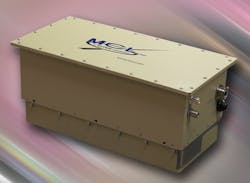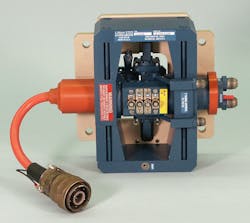Vacuum electron devices such as traveling-wave tubes (TWTs) may be considered “archaic technologies” by some—especially in an age of solid-state devices with ever-increasing power densities, such as gallium nitride (GaN) transistors. But vacuum devices still play vital roles in RF, microwave, and millimeter-wave applications across numerous markets, including broadcast, commercial, industrial, and military systems. When the need arises for very high power density at high frequencies, solid-state technology still doesn’t come close to the capabilities of vacuum electron devices like TWTs, klystrons, and magnetrons.
For commercial use, satellite-communications (satcom) systems employ a large number of high-frequency vacuum electron devices because of their needs for such high power densities to send high-power signals across considerable distances. But the high power densities afforded by vacuum tube devices are also essential to research applications in nuclear science; medical electronic systems; air-traffic-control (ATC) systems; and military and commercial systems. One of the largest groups of vacuum-tube-based solutions is based on TWT technology and traveling-wave-tube-amplifier (TWTA) devices.
For example, Communications & Power Industries (CPI) offers high-throughput-satellite (HTS) services for both continuous-wave (CW) and pulsed applications from UHF through Ka-band frequencies. As an example, the firm’s model VKU-7891 TWTA provides 40-dB gain and 3 kW CW output power from 14.0 to 14.5 GHz while operating with 11 kV beam voltage and 1.1 A beam current. CPI recently received an order for more than $6 million for Ka-band high-power satcom amplifiers for HTS services. Late last year, the company also received orders from a US military prime contractor in excess of $5 million for both solid-state and vacuum-electron-device amplifiers, including the company’s SuperLinear® high-power Ka-band satcom TWTAs. Since 1977, the company has also delivered in excess of 130 gyrotrons and produced more than 16 experimental vehicles; these range in frequency from 8 to 250 GHz, featuring output power levels from 900 kW CW and 1.3 MW pulsed output power.
Some vacuum tubes, such as magnetrons, generate rather than amplify signals by applying high-voltage energy to a series of resonant cavities. The energy fed into the resonant cavities must be carefully controlled in terms of phase and level. A heated cathode in a magnetron is the source of electrons. The electrons leave the cathode and accelerate towards the magnetron’s anode due to the magnetic field resulting from the applied voltage. The frequency of the electrons is affected by the effects of their traveling through the resonant cavities.
For some radars, frequency-agile magnetrons (which are available from CPI in various forms) can help improve the system’s capabilities to detect targets in environments plagued by a great deal of signal clutter, such as other sources of RF/microwave energy. Increasing the pulse-to-pulse frequency spacing can increase the detection capability of a radar system, although the magnetron must be capable of turning on and off relatively short pulses. A number of different types of frequency-agile magnetrons are available, including dither magnetrons with output frequency that varies periodically with a constant excursion and fixed center frequency.
In contrast, some magnetrons, such as beacon magnetrons developed for use in radar transponders, must be fairly small. This type of microwave vacuum electron tube produces about 5 W output power and weighs less than 8 oz. It must be frequency stable without additional electronics in a radar transponder, yet remain stable in frequency with temperature.
MCL, Inc., a MITEQ Company has long supplied compact and reliable TWTA products for satcom applications, including the recent development of the antenna mount model MT2400 TWTA for Ku-band outdoor satcom uplink and satellite-news-gathering (SNG) applications (Fig. 1). This tube amplifier is supplied in a light-weight, weather-resistant package measuring 8.9 × 8.12 × 17.3 in. (226 × 206 × 440 mm) and weighing about 32 lbs (14.5 kg) with forced-air cooling. The TWTA, which provides 208 W (+53.2 dBm) output power from 13.75 to 14.50 GHz (as much as 400 W peak output power), is available with gain levels of 60 or 70 dB, depending upon option, with worst-case gain variation of 1 dB per 80 MHz for narrowband use and 2.5 dB per 500 MHz for full-band use.
1. Model MT2400 is a high-power antenna-mountable Ku-band amplifier based on a TWT active device for satcom and SNG applications. (Photo courtesy of MCL, Inc., a MITEQ Company.)
The TWTA, which is designed to meet ML-188-164A requirements, includes an Ethernet interface for computer connection and continuous attenuator adjustment in 0.1-dB steps. The amplifier features a Type-N female input connector and WR-75G Ku-band waveguide flange at the output port. It has an operating temperature range of -40 to +60°C. The compact outdoor TWTA can be customized through a variety of options, including an additional input solid-state amplifier (SSA), internal linearizer circuitry, and an input L-band block frequency upconverter.
Teledyne MEC offers a website with an excellent technical section on vacuum electron devices, including thorough descriptions of key parameters, including gain, efficiency, noise, and reliability. The firm also offers a number of high-performance, broadband TWTs through microwave and millimeter-wave frequencies.
Model MEC 5424 provides minimum CW output power of 250 W from 6 to 18 GHz, with 35 dB gain at 6 GHz, 46 dB gain at 12 GHz, and 35 dB gain at 18 GHz. It achieves typical saturated output power of 275 W at 6 GHz, 300 W at 12 GHz, and 275 W at 18 GHz with an operating temperature range of -40 to +85°C. For higher frequencies, the company also offers model MEC 5496, with 40-W minimum CW output power from 26.5 to 40.0 GHz. It achieves 40 W typical output power at 26.5 GHz, with 45-dB typical gain. The typical output power is 50 W at 30 GHz, with 50-dB typical gain; 60 W typical output power at 36 GHz, with 50-dB typical gain; and 40 W typical output power at 40 GHz, with 35-dB typical gain. The TWT is designed for typical heater power of 0.7 A at -6.3 VDC, with cathode energy of -13.5 kV at 100 mA, and 6.75 kV at 10 mA for collector No. 1 and 3.38 kV at 80 mA for collector No. 2.
The TH 3977 DH series of TWTs from the Thales Group features tubes with a dual-stage collector design for high efficiency and periodic-permanent-magnet (PPM) focusing. The tubes are available with typical gain of 50 dB from 17.3 to 18.4 GHz with continuous output-power levels as high as 750 W across that frequency range. The conduction-cooled TWTs are ideal for direct-broadcast-satellite (DBS) uplinks as well as for SNG applications.
Of course, the history of high-frequency vacuum electron devices has not been restricted to this country: In Japan, Toshiba Electron Tubes & Devices Co. Ltd. developed a high-power klystron for UHF television broadcast applications as far back as 1961. The company has developed some of the world’s most powerful klystrons, including units capable of 1.2 MW continuous output power at 508 MHz and 100 MW pulsed output power at 2.8 GHz using period-permanent-magnet (PPM) focusing. At higher frequencies, the firm’s model E3845 TWT delivers 12.5 kW continuous output power for satcom applications from 9.2 to 9.5 GHz. It features forced-air cooling and long-life, high-current-density cathodes for high reliability and high output power from a package measuring only 499 × 127 × 158 mm and weighing 12 kg.
A firm perhaps best known for its semiconductors, e2v, also offers a wide range of vacuum electron devices that includes klystrons, magnetrons, and helix TWTs. The company offers narrowband and wideband devices for commercial and military applications, including the model N10110 helix TWT for use from 6 to 18 GHz. It offers 45-dB gain across that range with 180-W CW minimum output power. Designed for 6200-V cathode voltage, the tube measures 329 × 50 × 62 mm.
Finally, L-3 Electron Devices Division, which began life as part of Litton Industries, offers a variety of vacuum electron tube devices for medical, broadcast, and military applications, including helix and coupled-cavity TWTs, klystrons, crossed-field amplifiers (CFAs), magnetrons, and thyratrons (Fig. 2). The company, which offers miniature TWTs for use from 2 to 46 GHz, produces devices with output levels as high as 5 kW average output power and 150 kW peak output power across 10% operating bandwidths at C-, X-, and Ku-band frequencies. It also produces microwave power modules (MPMs), which are complete microwave power amplifiers based on a TWT, a solid-state driver amplifier, and an electronic power conditioner (EPC).
2. This high-power amplifier is based on a klystron vacuum electron device and includes power supply, active device, and supporting circuitry. (Photo courtesy of L-3 Electron Devices Division.)
These are a few examples of the high pulsed and CW output-power levels possible with vacuum electron devices at RF, microwave, and millimeter-wave frequencies. Although they must be powered by high-voltage supplies, these devices still deliver considerably higher power densities that possible with high-frequency solid-state devices, and likely that will continue for many years to come.
About the Author
Jack Browne
Technical Contributor
Jack Browne, Technical Contributor, has worked in technical publishing for over 30 years. He managed the content and production of three technical journals while at the American Institute of Physics, including Medical Physics and the Journal of Vacuum Science & Technology. He has been a Publisher and Editor for Penton Media, started the firm’s Wireless Symposium & Exhibition trade show in 1993, and currently serves as Technical Contributor for that company's Microwaves & RF magazine. Browne, who holds a BS in Mathematics from City College of New York and BA degrees in English and Philosophy from Fordham University, is a member of the IEEE.


